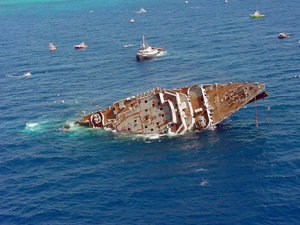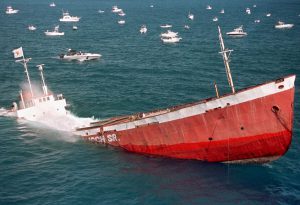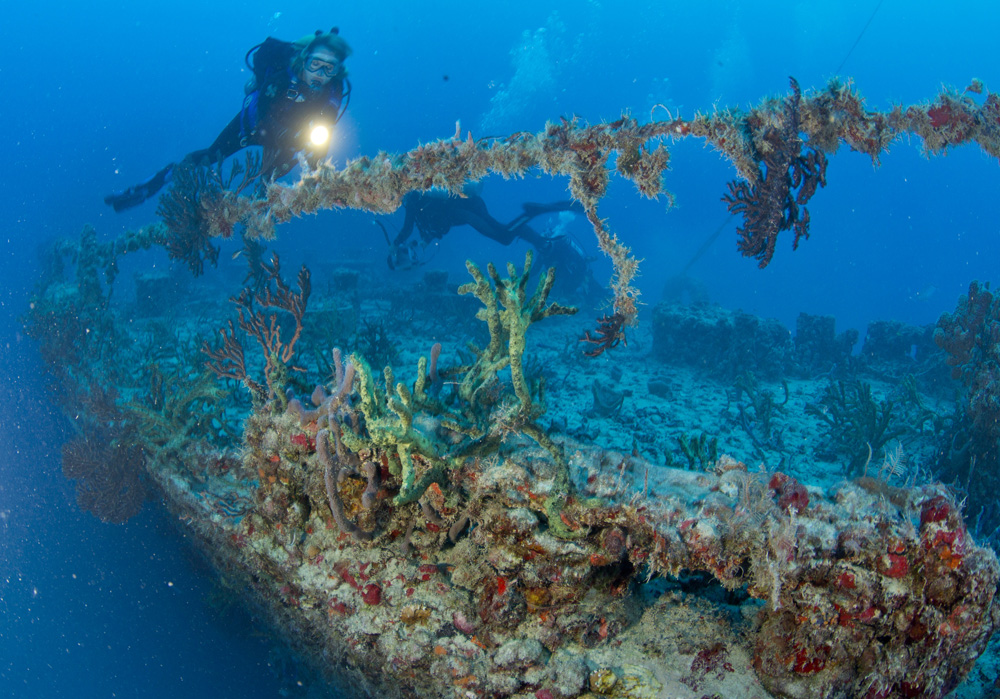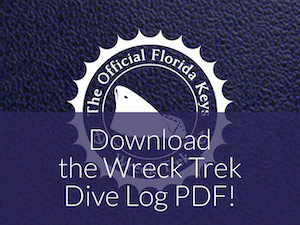Vessels intentionally sunk to create artificial reefs serve as refuges for fish, delicate corals and invertebrates — and provide fascinating sites for divers to explore.

The Spiegel Grove rolled over after it sank prematurely in the waters off Key Largo. (Photo by Sergio Garcia, Florida Keys News Bureau)
In addition to the shipwrecks’ own allure, any life and growth on them adds to the habitat. So if you spend time looking for the little things like blennies, shrimp, tiny lobsters, fish eggs, sponges, feather dusters and tube worms, you’re also likely to see a lot more: hogfish, parrotfish, squid, hammerhead sharks and many other large species of marine life that you don’t normally spot on a coral reef.
Within the Florida Keys National Marine Sanctuary, which protects the waters surrounding the island chain, lie nine notable wrecksites that are part of the popular Florida Keys Wreck Trek. Among them is the following “awesome threesome” for advanced- and wreck-certified divers.
SPIEGEL GROVE. Spiegel Grove is the world’s third-largest vessel intentionally sunk to make an artificial reef, and it’s positioned in 130 feet of water about six miles off Key Largo. Designed to carry cargo and craft for amphibious landings, the ship was retired by the Navy in 1989.
Slated for an intentional scuttling on May 17, 2002, the retired 510-foot ship prematurely sank and rolled over, leaving its upside-down bow protruding above the surface of the water. Three weeks later, a salvage team managed to fully sink the vessel and it came to rest on its starboard side.

Thunderbolt, originally named Randolph, was sunk as a dive attraction off Marathon in 1986. (Photo by Stephen Frink)
After more than three years of welcoming divers in that position, Spiegel Grove benefited from a hurricane that brushed the Florida Keys in July 2005 — creating wave motion strong enough to push the wreck into the upright position originally planned.
Today, the top deck of Spiegel Grove is about 60 feet below the ocean surface. The ship is so wide that, on many days, the view of the superstructure will fade into a green-blue abyss. On the clearest days, the sandy bottom is visible at a depth of about 130 feet from the surface. Mooring buoys provide convenient, coral-friendly boat tie-offs.
THUNDERBOLT. The waters off Marathon are home to Thunderbolt, called the “queen of the Marathon wreck fleet.” A 188-foot cable layer, it also served as a research vessel to explore the electrical energy of lightning strikes.
Originally named Randolph, Thunderbolt was sunk as a dive attraction in 1986. It lies in approximately 120 feet of water 6.5 miles south of Duck Key Channel.
Divers can navigate this entire wreck during one dive, accessing it by following the line of a submerged mooring ball positioned at the bow. Thunderbolt sits upright, and the top of the observation deck is 75 feet beneath the surface.
Its most notable feature is a giant cable spool at the bow — and the wheelhouse is an easy and intriguing swim-through. The aft end of the wreck has been cut away to expose the engine room and the interior of the hull. The rudder and propellers were left on the ship to complement the stern section of the hull and appeal to divers.

The Adolphus Busch Sr., a former island freighter renamed to memorialize the patriarch of the Busch brewing family, was intentionally sunk in 1998 to create an artificial reef to take pressure off natural coral reefs and create new marine habitats. (Photo by Andy Newman, Florida Keys News Bureau)
Thunderbolt’s superstructure is coated with colorful sponges, corals and hydroids, providing refuge and sustenance to large angelfish, barracuda, jacks, cobia, hogfish, tarpon and deep-water pelagic creatures including goliath and black grouper.
ADOLPHUS BUSCH SR. The 210-foot Adolphus Busch lies between world-famous Looe Key and American Shoal, about six miles southwest of Big Pine Key.
Built in Scotland in 1951, the ship was intentionally sunk in 112 feet of water in 1998. No explosives were used in the sinking; instead, after hatches and portholes were removed for safety, 12 holes were drilled into the vessel and water was pumped into its hull.
It settled upright and in perfect condition on a sandy bottom, with its wheelhouse at 70 feet and its main deck at 90 feet.
The Busch’s life as a short-haul island freighter was interrupted in 1957 by a call from Hollywood. The vessel co-starred with Robert Mitchum, Jack Lemmon and Rita Hayworth in the film, “Fire Down Below.”
Previously called the London and several other names, the ship was christened Adolphus Busch Sr. by the Anheuser-Busch brewery founder’s grandson, Adolphus Busch IV, an avid diver and fisherman — who envisioned it as a permanent memorial to his grandfather.
DIVERS, PLEASE NOTE: For a normal wreck dive, it’s recommended (and sometimes required) that participants be properly certified and trained advanced and wreck divers.
If you have open-water certification, local dive shops may request your logbook or dive computer to review for air management skillsand proof of a dive to 100 feet within the last year.
Want to know more about the Florida Keys Wreck Trek and its shipwrecks awaiting exploration? Just click here.


